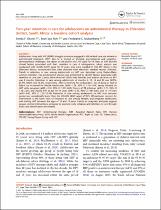| dc.description.abstract | Adolescents living with HIV (ALHIV) struggle to remain engaged in HIV-related care and adhere to
antiretroviral treatment (ART) due to a myriad of physical, psychological and cognitivedevelopmental challenges. We report on the profile of ALHIV aged 10–19 years on ART and the
clinical factors associated with their retention in care. A retrospective cohort analysis was
conducted with 16,108 ALHIV, aged 10–19 years, who were enrolled in 136 ART clinics in the
Ehlanzeni district. Anonymised data were obtained from electronic medical records (Tier.net).
Trends in retention in care among adolescents on ART was described using Kaplan-Meier
survival estimates. Cox proportional analysis was performed to identify factors associated with
retention in care over 2 years. More than half (53%) were females, and median duration on ART
was 8 months. Retention in care among adolescents at months 6, 12, 18 and 24 was 90.5%,
85.4%, 80.8% and 76.2%, respectively. After controlling for confounders, risk of dying or lost to
follow up increased for female adolescents (aHR = 1.28, 95% CI 1.10–1.49); being initiated on
ART while pregnant (aHR = 2.72, 95% CI 1.99–3.69); history of TB infection (aHR = 1.71, 95% CI
1.10–2.65); and started ART at age 10–14 years (aHR = 2.45, 95% CI 1.96–3.05), and 15–19 years
(aHR = 9.67, 95% CI 7.25–12.89). Retention in care among adolescents on ART over two-year
period was considerably lower than the UNAIDS 2030 target of 95%. Of particular concern for
intervention is the lower rates of retention in care among females and pregnant adolescents
and starting ART between the ages of 10 and 19 years. Family or caregivers and peer support
groups centred interventions designed to promote early initiation and retention in care through
early case identification are needed. | en_US |

